As your Temecula Chiropractor…
…there are a tremendous number of ailments that you could see improvements on using our chiropractic techniques. These include:
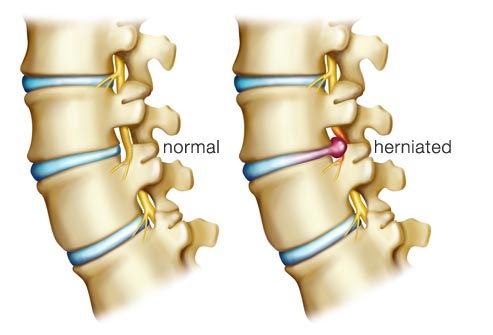 Disc Herniation
Disc Herniation
A spinal disc herniation, incorrectly called a “slipped disc”, is a condition affecting the spine, in which a tear in the outer, fibrous ring on an intervertebral disc allows the soft, central portion to bulge out. Degenerative disc disease makes the disc more susceptible to herniation (rupture) which can lead to localized or radiating pain. The pain from degenerative disc or joint disease of the spine is usually treated conservatively with rehabilitative excercises, gentle chiropractic adjustments and non-surgical spinal decompression. In many instances an MRI will be requested.
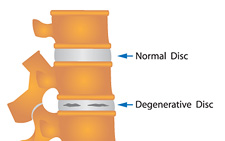 Degenerative Disc Disease
Degenerative Disc Disease
Degenerative disc disease makes the disc more susceptible to herniation (rupture) which can lead to localized or radiating pain.
The pain from degenerative disc or joint disease of the spine is usually treated conservatively with gentle chiropractic adjustments, non-surgical spinal decompression, stretches, and exercises.
Sciatica
Pain, caused by irritation of the sciatic nerve, typically radiates from the low back, down the leg to the foot. Disc herniation is usually the cause of sciatica. Non-surgical spinal decompression is an excellent choice for treatment of sciatica with a high percentage of success!
Spondylolisthesis
A condition in which a bone (vertebra) in the lower part of the spine slips forward with relation to the vertebra below it.
Headaches
80% of all headaches are muscle tension. Headaches are associated with strain to the neck from postural and biomechanical compromise. These are the easiest to correct with adjustments and improvement of overall alignment.
Migraines
Migraine is usually periodic attacks of headaches on one or both sides of the head. These may be accompanied by nausea, vomiting, increased sensitivity of the eyes to light (photophobia), increased sensitivity to sound (phonophobia), dizziness, blurred vision, cognitive disturbances, and other symptoms. Many long-term sufferers have experienced relief with specific chiropractic treatments and nutritional support, counseling, and supplements.
Chemical/Hormonal Headaches
Headachess attributed to excess environmental exposure or to preservatives, chemicals, dyes, and artificial sweeteners creating toxicity and/or hormonal imbalance. These can often be treated by specific dietary changes in addition to adjustments and nutritional counseling.
Neck Injuries
There are many types of neck injuries most of which are treatable with conservative methods. It is important to receive the right diagnosis to know the best combination of treatments necessary to ensure a successful outcome.
 Whiplash
Whiplash
Whiplash is the common name for neck sprains, such as those caused by hyper extension/flexion injury to the cervical, thoracic or lumbar spines. The injury is referred to as “whiplash” due to the neck or back being thrown forwards and/or backwards at a rapid speed. This may cause the fibers of the neck muscles to tear, resulting in pain and often a decreased range of movement. Whiplash is commonly associated with motor vehicle accidents, usually when the vehicle has been hit in the rear, however the injury can be sustained in many other ways. With our rehab programs, you’ll be back on track ASAP – usually with less, if any residuals. Whiplash is usually caused by automobile accidents.
Cervical Sprain/Strain
See Whiplash.
Torticollis
Bending or twisting your neck too far can lead to acute torticollis. This condition appears with few symptoms, although often you will appear uncomfortable and will hold your head straight or rotated to one side. It will hurt to move your head to the opposite side. Your neck muscles on the side that hurts often are tender to the touch. Caused by an acute spasm of one or more neck muscles. This can often be released with one adjustment.
Rib Sprains
A common problem that can mimic heartache.If your heart checks out OK, then manipulaton and physiotherapy can be very beneficial.
Spinal Injuries involving Spinal Cord and Nerves
This type of injury can be postural, usually from excessive forward hunching or traumatically related. These can be very serious and should be examined promptly.
 Scoliosis
Scoliosis
Scoliosis is a sideways curvature of the spine, or backbone. The bones that make up the spine are called the vertebrae. The degree of scoliosis ranges from mild to severe. Patients with milder curves may only need to visit their doctor for periodic maintenance. Persons with more severe scoliosis may require more progressive treatment programs.
 Kyphosis
Kyphosis
Forward hunch of the upper spine. It can be either the result of bad posture or a structural anomaly (in the spine). We are specialists at recognizing and correcting this problem with our well established rehab protocols.
Subluxations
A vertebral subluxation is defined as a relatively common condition in which a spinal vertebra has lost its proper positioning with one or both of its neighboring vertebrae. We utiilize a variety of modern techniques to treat every patient’s needs.
Thoracic Outlet Syndrome
Thoracic Outlet Syndrome is a condition where symptoms are produced from compression of nerves or blood vessels because the passageway through the neck and armpit is inadequate. Symptoms of thoracic outlet syndrome include neck, shoulder and arm pain, and numbness or impaired circulation to the arms and hands.
 Carpal Tunnel Syndrome
Carpal Tunnel Syndrome
Carpal tunnel syndrome is a condition in which irritation of the wrist’s median nerve causes tingling and numbness of the thumb, index, and the middle fingers. This condition is known as tarsal tunnel syndrome in the ankles and feet. Repetitive motions, obesity, pregnancy, hypothyroidism, arthritis, diabetes, and trauma are conditions known to cause carpal tunnel syndrome. It is usually associated with tendonitis in the forearm. Treatment of carpal tunnel syndrome depends on the severity of the symptoms and the nature of any disease that might be causing the symptoms.
Sports Injuries
Most sports injuries respond well to chiropractic care. It is important to get the right diagnosis to know the best combination of treatments to ensure a fast acting, long lasting recovery.
Tendonitis
Tendonitis is a painful disorder of a tendon. Generally tendonitis is referred to by the part of body involved, such as Achilles tendonitis (affecting the Achilles tendon), or patellar tendonitis (jumper’s knee, affecting the patellar tendon). Chronic overuse of tendons leads to microscopic tears within the collagen matrix, which gradually weakens the tissue causing tendonitis. This is generally treated with ultrasound or electrical stimulation, deep therapeutic massage, heat or ice depending on chronicity and nutritional support.
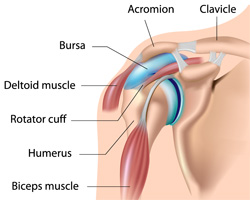 Bursitis
Bursitis
Bursitis is inflammation of a bursa. A bursa is a tiny fluid-filled sac that functions as a gliding surface to reduce friction between tissues of the body. There are 160 bursae in the body. The major bursae are located adjacent to the tendons near the large joints, such as the shoulders, elbows, hips, and knees. This is generally treated with ultrasound or electrical stimulation, deep therapeutic massage, heat or ice depending on chronicity and nutritional support.
 Plantar Fasciitis
Plantar Fasciitis
Heel spurs, pointed, bony outgrowths of the heel, are caused by localized soft tissue inflammation and can be located at the back of the heel or under the heel, beneath the sole of the foot. Plantar fasciitis is associated with inflammation caused by heel spurs on the soles of the feet. Both conditions are treated with gentle chiropractic adjustments and myofascial release techniques as well as ultrasound and electrical stimulation. Orthotics may also provide some relief.
TMJ
Temporomandibular joint disorder, or TMJ, is a disorder of the temporomandibular joint(s) that causes signs and symptoms including ear pain, bite problems, headaches, dizziness, clicking sounds in the jaw, tinnitus and/or locked jaws. Behaviors or conditions that can lead to TMJ include teeth grinding or clenching, fingernail biting, habitual gum chewing, trauma to the jaw, stress, and occupational hazards. Treatment for TMJ may include heat, ice, a soft diet, gentle chiropractic adjustments, massage, physiotherapy, stress management, occlusal therapy, and correction of bite abnormalities.
 Tennis Elbow
Tennis Elbow
Elbow pain may be caused by tendonitis, olecranon bursitis, fractures, sprains, arthritis, cellulitis, tumors, and ulnar nerve entrapment. Inflammation, redness, warmth, swelling, tenderness, and decreased range of motion are other symptoms associated with elbow pain. Treatment for elbow pain depends upon the nature of the patient’s underlying disease or condition. This is generally treated with ultrasound or electrical stimulation, deep therapeutic massage, heat or ice depending on chronicity and nutritional support.
Golfer’s Elbow
Elbow pain may be caused by tendonitis, olecranon bursitis, fractures, sprains, arthritis, cellulitis, tumors, and ulnar nerve entrapment. Inflammation, redness, warmth, swelling, tenderness, and decreased range of motion are other symptoms associated with elbow pain. Treatment for elbow pain depends upon the nature of the patient’s underlying disease or condition. This is generally treated with ultrasound or electrical stimulation, deep therapeutic massage, heat or ice depending on chronicity and nutritional support.
 Shoulder Bursitis
Shoulder Bursitis
Subacromial bursitis, also called shoulder bursitis, is inflammation of the subacromial bursa, which lies between the acromion and the head of the humerus leading to extreme pain. The cause of the condition is often unclear. It can in some cases be blamed either on repeated minor trauma or on a single more significant injury, but in a large percentage of sufferers there is no obvious or remembered cause. This is generally treated with ultrasound or electrical stimulation, deep therapeutic massage, heat or ice depending on chronicity and nutritional support.
Bicep Tendonitis
Inflammation of the bicep tendons, more often the proximal long head of the biceps tendon causing pain of the anterior shoulder. A frequent problem associated with bench pressing. This is generally treated with ultrasound or electrical stimulation, deep therapeutic massage, heat or ice depending on chronicity and nutritional support.
Labrum Tear
Injury to the cartilage cup that holds the humerus. Best seen with an MRI arthrogram.
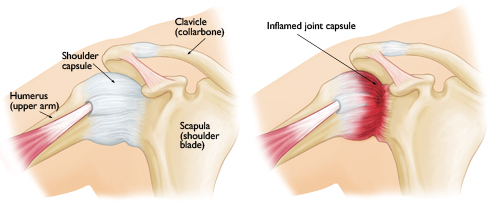 Adhesive Capsulitis
Adhesive Capsulitis
Frozen shoulder, referred to as adhesive capsulitis, is a disorder in which the shoulder capsule, the connective tissue surrounding the glenohumeral joint of the shoulder, becomes inflamed and stiff. Movement of the shoulder is severely restricted. The condition is sometimes caused by injury that leads to lack of use due to pain but also often arises spontaneously with no obvious preceeding trigger factor. To prevent the problem, a common recommendation is to keep the shoulder joint fully moving to prevent a frozen shoulder. Often a shoulder will hurt when it begins to freeze. Because pain discourages movement, further development of adhesions that restrict movement will occur unless the joint continues to move full range in all directions. Therapy will help one continue movement to discourage freezing and warm it.
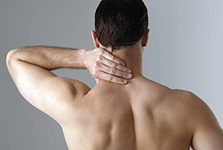 Cervicobrachial Syndrome
Cervicobrachial Syndrome
A pinched nerve in the neck that radiates down the arm.
Pinched Nerves
Compression or chemical irritation to a nerve causing pain that radiates down the nerve.
Muscle Contracture
Shortening of a muscle.
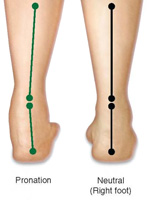 Ankle Pronation
Ankle Pronation
Rolling inward of the foot and ankle associated with flat feet. Usually treated with orthotics or arch support.